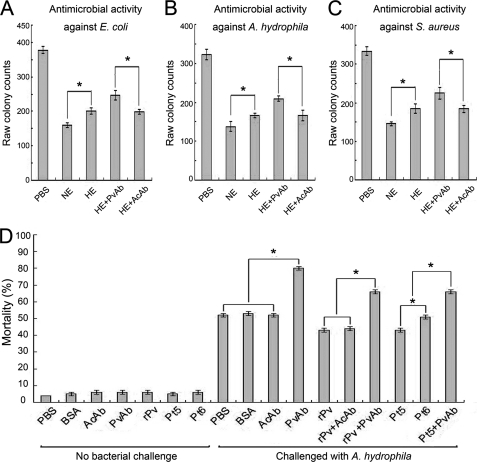FIGURE 1.
Antimicrobial activities of Pv in vitro and in vivo. A, antimicrobial activity of the embryo extract against E. coli; B, antimicrobial activity of the embryo extract against A. hydrophila; C, antimicrobial activity of the embryo extract against S. aureus; D, effects of microinjected recombinant Pv, Pt5, and Pt6 as well as anti-fish Pv antibody on the antimicrobial activity of the embryos. The early (8-cell stage) embryos were first microinjected and then challenged by injection of live A. hydrophila 1 h later. The mortality was recorded, and the cumulative mortality was calculated at 24 h following the bacterial injection. About 95% of the nonbacterial challenge control embryos developed normally. The challenge with live A. hydrophila resulted in a significant increase in the mortality of the embryos microinjected with anti-Pv antibody but not the embryos injected with anti-actin antibody or BSA or PBS. Microinjection of rPv or Pt5 into the embryos was able to increase their resistance to A. hydrophila, whereas the injection of Pt6 into the embryos was not. Co-injection of anti-Pv antibody together with rPv or Pt5 was able to counteract their activity to enhance the embryonic resistance to A. hydrophila. All data were expressed as mean values ± S.E. (n = 3). The bars represent the mean ± S.E. The asterisk means a significant difference (p < 0.05). NE, embryo extract; HE, heated embryo extract; PvAb, anti-fish Pv antibody; AcAb, anti-actin antibody; BSA, bovine serum albumin; Pt1, Pt2, Pt3, Pt4, Pt5, and Pt6 are the six truncated products of Pv (see Fig. 6).

